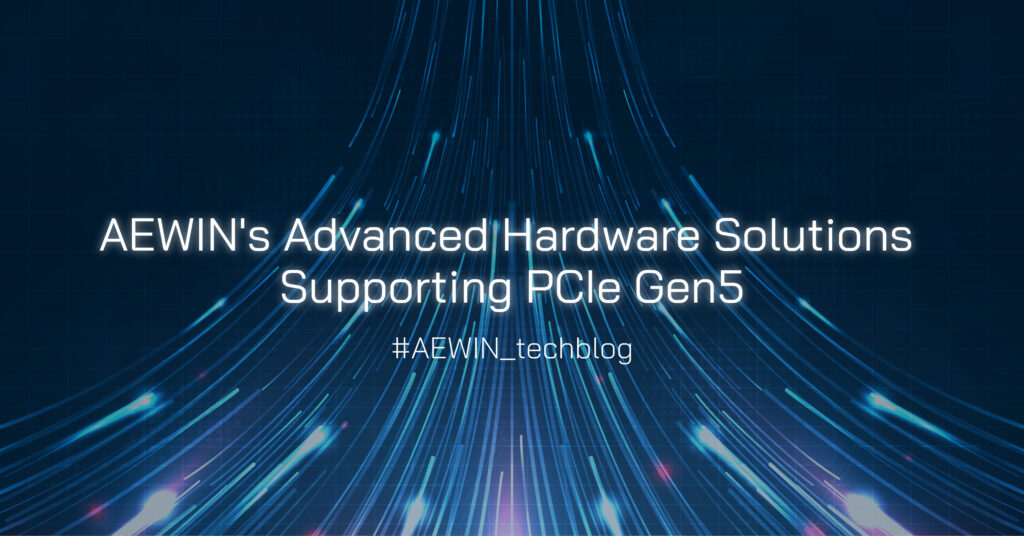
Introduction
In the ever-evolving world of computing and networking, the need for faster data transfer and efficient hardware solutions is surgically increased. AEWIN as a provider of high-performance network appliances, has embraced the latest technological advancements by supporting PCIe Gen5. In this Tech Blog, we will talk about the efforts AEWIN has made to achieve PCIe Gen5 support, the features and benefits of this technology, and its applications in various domains.
Efforts to Achieve PCIe Gen5 Support
AEWIN has invested significantly in cutting-edge technologies and design innovations to ensure reliable support of PCIe Gen5. Key efforts include:
- Signal Simulation
AEWIN conducts extensive signal simulations during the design phase to identify and address potential signal integrity issues. It can be divided into two key stages:
Pre-Simulation: An initial signal simulation is performed based on a preliminary placement of components. This simulation helps evaluate factors such as trace length, impedance, crosstalk, components, and cables. By analyzing these aspects early on, guidelines can be established for designers to come up with smoother progress and better design outcomes.
Post- Simulation: Once PCB trace & via of main high-speed signals are ready, post-simulation will be processed with IBIS (I/O Buffer Information Specification) models to check the signal integrity and identify areas that requires optimization. Fine-tuning trace lengths, adjusting impedance, and addressing crosstalk issues would be done to ensure the design meets performance requirements and reliability.
Theses proactive approaches help to optimize the layout to ensure that the final product meets the stringent performance requirements of PCIe Gen5.
- Retimer
AEWIN incorporates retimers on certain cases to support longer distances and maintain signal integrity. Retimers help to enhance the signal to ensure that the signal quality meets PCIe Gen5 standards for upper layer expansion of servers and network appliances.
- MCIO (Mini Cool Edge IO)
AEWIN’s use of MCIO connectors facilitates high-speed data transfer with minimal signal degradation. MCIO connector addresses the SFF-TA-1016 next-generation industry standard defined by SNIA and provide high-speed support meeting PCIe Gen5 standard defined by PCISIG with a MCIO cable.
- CCL (Copper Clad Laminate)
To achieve the high-speed data transmission required by PCIe Gen5, AEWIN utilizes ultra-low loss CCL. These materials minimize signal loss, ensuring data integrity and reducing the power consumption.
Beyond using ultra-low loss CCL, AEWIN leverages its design know-how to strategically combine low loss CCL. This approach not only supports stable PCIe Gen5 high-speed signals but also offers a cost-effective solution with balanced performance and value.
- PCB Back-Drill Design
The use of back-drilling in PCB design helps eliminate unwanted effects of parasitic capacitance caused by vias. This design approach reduces signal reflections and crosstalk to enhance signal quality and enable stable high-speed data rates.
- Signal & Functional Test
AEWIN applies PCIe Gen5 measurement test (from Preset 0-11) to confirm that the system PCIe ports are beyond the standard of PCISIG. Fixtures for different form factors are utilized during the testing process. In additional to signal verification, functional tests with multiple PCIe Gen5 expansion cards are included in the compatibility test with DPDK and throughput tests.
Features and Benefits of PCIe Gen5
PCIe Gen5 offers several significant enhancements over previous generation which make it a critical technology for modern computing and networking solutions:
- High Speed:
PCIe Gen5 doubles the data transfer rate of PCIe Gen4, offering up to 32 GT/s per lane and 63GByte/s with 16 lanes per direction. This increased speed enables faster data access and processing.
- Low Latency:
PCIe Gen5 reduces latency and ensures faster response times for connected devices. This feature is particularly important in applications requiring real-time data processing.
- Efficiency:
PCIe Gen5’s high bandwidth allows a single card to perform the functions of multiple cards in previous generations. This consolidation reduces the number of required components, lowering overall costs and simplifying system design.
- CXL Compliance:
The Compute Express Link (CXL) Consortium defines CXL specification based on PCIe 5.0 Base Specification and the max link rate of 0/1.1 and CXL2.0 are defined as 32GT/s. That is, PCIe Gen5 is essential for applying CXL features for memory expansion and resource utilization.
Applications of PCIe Gen5
The advanced capabilities of PCIe Gen5 open up a wide range of applications, including:
- Networking
PCIe Gen5 supports NVIDIA ConnectX-7 NIC (network interface card) with up to 400G and upcoming high throughput NICs powered by Intel E830 Ethernet controllers. The increased bandwidth and low latency of PCIe Gen5 enables high-speed network connectivity and reliable data transfer in data centers and enterprise environments.
- High Performance Computing
Enhanced data transfer rate of PCIe Gen5 make it ideal for supporting advanced GPU accelerators which require rapid data movement to efficiently process large amounts of datasets. It is crucial to reduce training times for complex AI models for enabling diverse intelligent applications.
- Storage Solutions
Next-generation storage solutions having strict demands of fast data access and retrieval are benefited from the high speed PCIe Gen5 supports. Based on PCIe Gen5, higher speed and larger capacity NVMe SSDs including U.2 and the latest EDSFF (E1.S, E3.S, etc.) are available to fulfill the up-to-date requirements of various kinds of modern storage applications.
Summary
AEWIN provides advanced hardware solutions with PCIe Gen5 support to meet the demands of modern computing and networking. By leveraging state-of-the-art technologies of high-speed PCIe Gen5, AEWIN makes its products delivering excellent performance, reliability, and efficiency for Networking, Edge AI, and Storage. As the industry continues to evolve, AEWIN remains at the forefront, providing cutting-edge solutions for a wide range of applications.